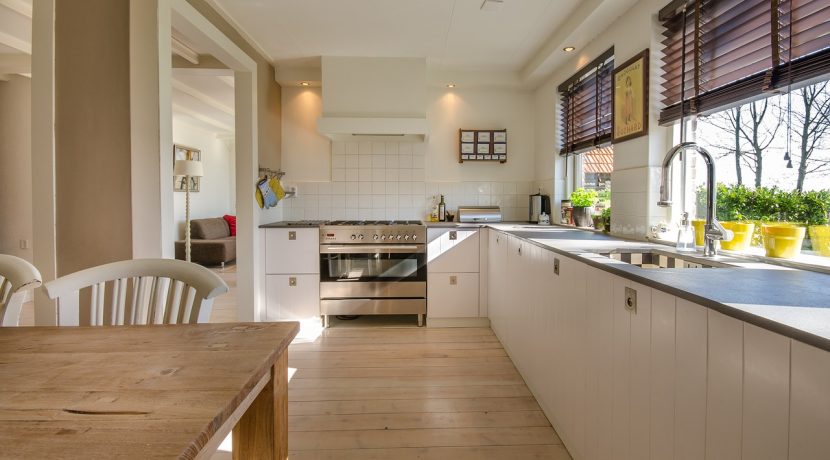Best Way to Paint Kitchen Cabinets
If your cabinets are old and outdated, but you’re unable to replace them yet, learn the best way to paint kitchen cabinets so you can update them. Paint can work wonders on everything, and kitchen cabinets are no exception. Painting kitchen cabinets can be tiring and you can easily hire a pro to do the job for you, but if you’re up for the challenge and want to save the money, do it yourself. There’s something truly amazing about the fresh smell from painting kitchen cabinets. It announces that everything is new and clean again, like a brand new day, in any color you want, applied in any design or style you want.
Painting is a relatively inexpensive way to upgrade outdated kitchen cabinets; you just have to determine whether or not your cabinets can be painted. Wood, wood veneers and metal can be painted with fantastic results. Laminate and melamine, not so much. Once you know for sure your cabinets can accept the paint, all you really have to do is block out two or three weekends to do a thorough job that isn’t rushed. Go to your nearest home improvement store for supplies, throw in a sense of adventure with as much elbow grease as you can muster, and your kitchen cabinets can be transformed into a showplace you’ll enjoy for years to come.
Your next decision is whether to spray or brush. There are pros and cons to both methods. Spraying the paint will give you a cleaner, smoother, more professional look without leaving behind brush strokes, but it is more time-consuming and will require buying or renting a sprayer (plus making a few practice runs before the real work begins). This method works especially well if your cabinets have a lot of nooks and crannies, intricate designs and raised panels. If you choose this method, just be sure to cover and protect every single aspect of your kitchen, as well as any doorways and open areas in order to prevent tiny little spray particles from permeating throughout the house and onto unintended surfaces.
Using a paint brush works really well for simple cabinet designs, and it is easily the least complicated method. The trick with using a brush instead of a sprayer is in the sanding after each coat of paint to give it a smoother overall finish. With both methods, you’ll want to use a small foam roller brush to paint the inside of the cabinet boxes.
Your most time-consuming decision is going to be in choosing your paint color. Whether you choose one solid color throughout or a base color with a complementary accent color, paint is the most personal expression of your own special style. Painting your kitchen cabinets requires a commitment and will make your kitchen all but unusable for a couple of weeks.
When you’re ready to get started, clear off your kitchen counters, empty your cabinets, and cover your backsplash and appliances. Remove all of the hinges, hardware, doors and drawers from your cabinets. Label each door with masking tape so you’ll remember which one goes where and put all of the hardware in plastic bags so you don’t lose anything. If you can fit a worktable in your kitchen, it will be much easier to paint the doors. If you don’t have a large worktable, 2×4 boards propped on buckets or boxes will also work. If you don’t have those materials, work on top of a drop cloth.
You’ll want to prep all of the doors and drawers properly to ensure your paint will stick. Start this process by scrubbing your cabinets to get rid of any grease or residue. If you’re planning to use new hardware, cover the current holes with wood filler. Next, use 100-grit sandpaper to make all of the surfaces smooth and make sure to wipe away any dust with a tack cloth before drilling your new holes. To ensure a nice finish, use caulk to fill in any gaps or seams.
If you want professional-style results, it’s imperative to prime the boxes, door fronts and drawers before you begin painting. Once your primer has dried, use an angled brush and a mini foam roller to apply your paint. A latex satin finish works well on kitchen cabinets and it isn’t as hard to work with as oil paint. Start working in sections with your angled brush and go over your work with the roller for a perfect finish. When you’re done painting, you can also use very fine grit sandpaper for a final sanding and even a coat of a satin polycrylic for extra durability as well. Once your paint has dried, reinstall the doors and drawers and install your hardware.
Spray paint is another option for painting kitchen cabinets, but this process is best done outside or in a designated workspace so you don’t have to worry about overspray. If spray painting your cabinets, you’ll follow the same process as above but instead of working with a paint brush and roller you’ll use spray paint instead.
All rights reserved to the initial publisher for hgtv.com
Collected and published by Arms &McGregor International Realty® editorial team. Get in touch with us at [email protected]

